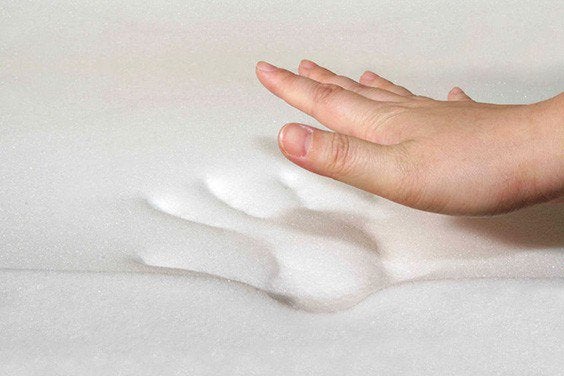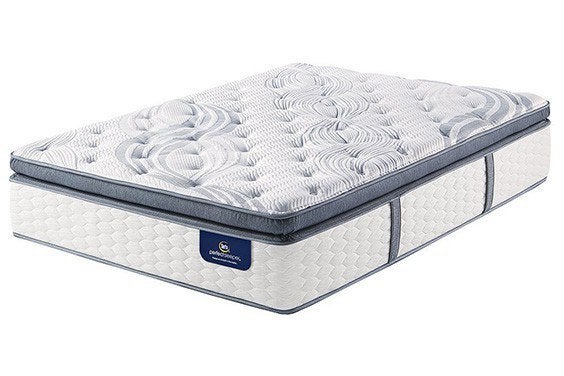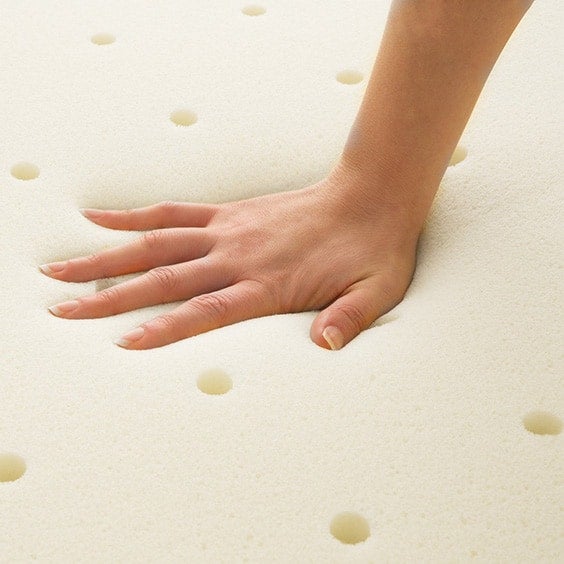Memory foam and pillow top mattresses are two higher end categories of bedding that consumers consider when they’re going for extra comfort and back pain relief. However, other than the fact that both of them fall in the luxury category, the two are quite different from each other and target sleepers with markedly different needs.
Without proper knowledge of these differences, you can end up spending a wad of cash on the wrong mattress that doesn’t address your comfort / pain relief needs. Here’s a memory foam vs pillow top comparison I’ve created from my years of experience in the bedding industry, to help you make the right choice.
What Is A Memory Foam Mattress?
A memory foam mattress is simply a mattress that incorporates a memory foam (viscoelastic foam) as a primary comfort material. While the support core of these mattresses normally consists of firmer polyurethane foam, there are instances of newer products that consist wholly of viscoelastic layers that get progressively firm.
These mattresses are characterized by the soft, conforming support that they provide to your body – it “remembers” the shape of your body, so as to provide optimum support and relief to your joints and muscles regardless of your sleeping posture.
Memory Foam Mattress – Pros and Cons
Pros
- Designed to yield high degree sinking, conforming support.
- Recommended for people with hip / shoulder / back pain.
- Durable.
Cons
- Expensive.
- Cheaper variants may raise temperature.
- Off gassing issues with cheaper products.
What Is A Pillow Top Mattress?
A pillow top mattress is one that has an additional layer of padding above its comfort layer. This padding usually contains a plush / responsive material such as cotton, down, latex – even memory foam in some cases!
The objective is to soften the feel of the underlying layers which may be too firm by themselves – for this reason, pillow tops are usually present in innerspring mattresses, to make their surface a bit plush for those who can’t handle the stiff, bouncy feel of a traditional spring product.
Pillow Top Mattress – Pros and Cons
Pros
- Offers some soft support without masking the feel of the layers underneath.
- Comparatively cheap.
- Doesn’t have significant impact on temperature.
- Lesser intensity / likelihood of off gassing.
Cons
- Degrades relatively quickly.
- Won’t offer much comfort to heavier individuals.
Economy
Viscoelastic mattresses typically run more expensive than regular polyurethane foam / innerspring units. Pillow tops are a compromise between comfort and economy, in that they enhance the responsiveness and comfort of the latter without actually adding on as much cost as a fully-fledged memory foam design.
In other words, if you want to save some cash but still require something that offers a semblance of conformity to better support your posture, pillow tops are the way to go.
Comfort
This is a largely subjective consideration, but it is generally agreed that the most comfortable and supportive bed is one that lets you sleep with your spine in perfect alignment and minimal stress on your pressure points.
By that metric, a memory foam mattress is far ahead of a pillow top offering, since it has an entire comfort layer comprised of a material that has been designed to shape itself according to your body. On the other hand, while a pillow top does offer a degree of contouring, there is a good chance that you’ll still feel some of the unyielding pushback of the firmer mattress underneath.
By extension, viscoelastic foam will also offer superior motion isolation as compared to a pillow top.
Durability
High quality memory foam i.e. the kind that has considerable foam density, lasts for an extended period of time, especially when it is paired with a sturdy support core. On the other hand, a frequent complaint with pillow tops is that they lose their shape after a few years, leading to discomfort during sleep.
It should be noted that the layers underneath the pillow top may still remain intact, so you could potentially get away by throwing on a mattress topper for a few years.
Thermal Regulation
Older generations of memory foam had a closed cell structure, which caused the temperature of the bed to rise considerably in spite of the comfort they provided. Future generations tackled this issue with shifting to an open cell structure and today, gel beads and other exotic substances have been infused into the foam to provide enhanced heat transport.
In spite of this, all but the highest tier of viscoelastic mattresses will lead to a palpable elevation in temperature. In contrast, pillow tops, by virtue of their limited thickness, will not significantly affect the temperature of your bed even if they incorporate viscoelastic. This holds true even better for pillow tops consisting of cotton, down, wool or latex.
Off Gassing
This refers to the release of gas, often accompanied by a noxious smell, from mattresses after they have been unrolled for the first time. It is most noticeable in products containing large amounts of artificial substances, and a memory foam mattress (unless it is derived from a plant based substance) definitely fits that bill.
The smell will also be perceptible in pillow tops if they contain an artificial latex / natural latex blend, or viscoelastic foam. Of course, this will be to a lesser degree as compared to a full on viscoelastic foam mattress.
The substances released in this manner – VOCs – may carry a small risk of respiratory problems, so make sure the mattress you choose comes with a healthy safety certification, or keep out of the room until the mattress has fully gassed itself out.
Pillowtops will offer a bit more freedom in this regard, in that you can choose a product that does not use a material that emits gas.
Memory Foam vs Pillow Top Mattress Specs
| Memory Foam | Pillow Top |
|---|---|
| Expensive | Economical |
| Fully fledged mattress comfort material forming layer(s) of several inches | Top level cushioning layer consisting of just a few inches of soft material |
| High degree of conforming support | Some semblance of conforming support while preserving the underlying feel of the mattress |
| Will last for many years, if high quality | Will degrade after some years, regardless of quality |
| Significant temperature raising effect, for cheaper products | Little effect on temperature |
| Off gassing issues, for cheaper products | Some off gassing concerns, but only if it uses artificial substances |
Conclusion
Ultimately, who you pick as the winner in the memory foam mattress vs pillow top mattress debate boils down to your priorities: If you want a solution that yields a high degree of contouring support for a lasting period of time, then memory foam is the way to go. If you’re willing to spend extra on a higher quality model, you may not even deal with the thermal and off gassing issues that viscoelastic foam is notorious for.
However, if you’re on a budget or if you’re not looking for an extreme level of sinking and conformity, then a regular polyfoam / innerspring mattress with a pillow top filled with a soft material will do you just fine.




